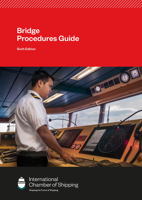Published February 2023
Published by International Chamber of Shipping
The IMO International Convention on Standards of Training, Certification and Watchkeeping for Seafarers (STCW) regulate the training and certification of seafarers and forms the basis for standards of crew competence that are enforced worldwide. The Convention also regulates watchkeeping arrangements on board merchant ships, including watchkeepers’ minimum rest hours.
New in this edition:
- Integrates new regulations that affect training, including:
- International Code of Safety for Ships using Gases or other Low-flashpoint Fuels (IGF Code).
- International Code for Ships Operating in Polar Waters (Polar Code).
- New requirements for familiarisation training for crew on Ro-Ro Passenger Ships.
- Changes to Chapter V regarding tanker training.
- Updated guidance for crews operating dynamically positioned (DP) vessels.
- Explains clearly how the STCW Convention relates to the IMO ISM Code and ILO MLC, particularly on watchkeeping.
- Includes colour coding to distinguish mandatory parts of guidance.
- Includes flowchart setting out exactly what training is needed for seafarers.
- Features a clearer layout and includes infographics and visual aids to improve reader experience.
This guide will help readers:
- Comply with regulations.
- Avoid lengthy delays at port for non-conformances.
- Know exactly what training crews need to work on board.
- Understand how the STCW works with other IMO and ILO regulations.
- Be completely up to date on the latest regulations.
The fourth edition of Guidelines on the IMO STCW Convention has been written and designed for use by crew, crewing managers, designated persons ashore (DPAs), Masters, personnel superintendents, recruiters, training superintendents, technical superintendents, and trainers and lecturers.
Table of Contents
Abbreviations
Chapter 1: The STCW Convention – an overview
1.1 Shipping company responsibilities
1.2 Uniform standards of competence
1.3 Measures to ensure implementation by governments
1.4 Other provisions
1.5 Structure, format and contents of STCW 2010
1.5.1 Structure
1.5.2 Format
1.5.3 Contents
Chapter 2: Company responsibilities
2.1 STCW 2010 and the ISM Code
2.1.1 Guidance on implementation of the IMO International Safety Management (ISM) Code relevant to STCW
2.2 Definition of ‘shipping company’
2.3 Explicit company responsibilities
2.3.1 Appropriate certification
2.3.2 Safe crewing
2.3.3 Refresher training
2.3.4 Record keeping
2.3.5 Shipboard familiarisation
2.3.6 Crew co-ordination
2.3.7 SOLAS communication
2.4 Minimum rest periods
2.5 Additional familiarisation and basic training
2.5.1 Familiarisation in elementary safety matters
2.5.2 Basic training
2.6 Additional training and certification requirements
2.6.1 GMDSS
2.6.2 Survival craft and fast rescue boats
2.6.3 Advanced fire fighting
2.6.4 Refresher training for survival craft, fast rescue boats and advanced fire fighting
2.6.5 Medical care
2.6.6 Security training
2.6.7 Leadership and teamwork
2.7 Other requirements
2.7.1 English language
2.7.2 Knowledge of maritime law
2.7.3 Prevention of drug and alcohol abuse
2.8 Best practice for instructors’ and supervisors’ qualifications
Chapter 3: The competence based approach to training
3.1 Training ‘outcomes’
3.1.1 Seagoing service
3.1.2 Training record books
3.2 Standards of competence
3.2.1 Competences
3.2.2 Functions
3.2.3 Levels of responsibility
3.3 Specification of standards of competence
3.4 Criteria for defining competence
3.4.1 Knowledge, understanding and proficiency
3.4.2 Methods for demonstrating competence
3.4.3 Qualifications of crew conducting in-service training and assessment
3.4.4 Simulator training
3.4.5 Evaluating competence
3.5 Alternative certification
3.6 Training for specific ship types
3.6.1 Passenger ships
3.6.2 Tankers
3.6.3 Offshore supply vessels
3.6.4 Ships in polar waters
3.6.5 Ships subject to the International Code of Safety for Ships Using Gases or Other Low-flashpoint Fuels (IGF Code)
Chapter 4: Implementation and enforcement
4.1 Ensuring compliance by companies
4.1.1 Penalties
4.1.2 Port State Control
4.2 Ensuring implementation by governments
4.3 The STCW ‘white list’
4.4 Quality standards
4.5 Flag State responsibilities
Chapter 5: Seafarer grades and certification introduced by the Manila amendments
5.1 Able seafarer deck
5.2 Able seafarer engine
5.3 Electro-technical officer
5.4 Electro-technical rating
Appendix
Recommended industry publications






























